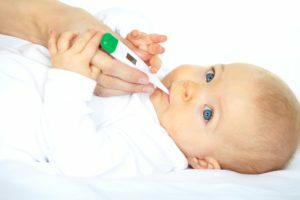 Increased temperature in a child often becomes a consequence of teething. When it's hot, it's important to understand its real cause and provide the baby with proper care so that a tiny organism can cope with the disease more easily.
Increased temperature in a child often becomes a consequence of teething. When it's hot, it's important to understand its real cause and provide the baby with proper care so that a tiny organism can cope with the disease more easily.
The increase in temperature is one of the characteristic symptoms of the fact that the teeth are climbing.
For the relief of the child's condition, you need to have special antipyretic drugs at your fingertips, properly organize the diet and adjust the microclimate in the children's room.
Also, you need to know how long this condition lasts and some features of temperature increase in this situation, so as not to miss the development of infection or another disease.
Contents
- Why does the temperature rise
- What is the most frequent temperature?
- How much hyperthermia lasts when teething
- How to measure the temperature of the baby
- If the permanent teeth
- climb What situations do I need to knock down the temperature
- How dangerous is the fever in a child?
- How to bring down the temperature
- Physical methods
- Drug therapy
- What can not be done categorically
- Child care
- Adjusting the ration
- Creating the appropriate microclimate
- Watching clothes and linen
- Situations requiring a doctor's consultation
- When the temperature indicates the development of diseases
Why the temperature rises
The cutting teeth must first pass through the bone tissue, and then through the mucous membrane of the gum. This process is accompanied not only by strong painful sensations, but also by development in the gum area of the inflammatory process.
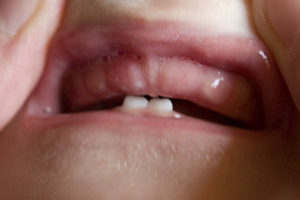 Due to the release of a large number of biologically active substances in the tooth growth zone and a sharp decrease in both local and general immunity, the temperature in babies also increases.
Due to the release of a large number of biologically active substances in the tooth growth zone and a sharp decrease in both local and general immunity, the temperature in babies also increases.
Usually, the temperature increase is insignificant because of the sharp increase in the child's salivation during this period, due to which the body naturally protects from possible infection.
The bactericidal and anti-inflammatory properties of saliva reduce the risk of inflammation spreading, supporting local immunity.
What is the most frequent temperature?
As a rule, the temperature rises to subfebrile values, not exceeding 37.5 degrees. But there are more difficult situations.
Opinion of Dr. Komarovsky on the causes of temperature increase in teething in children:
How much hyperthermia persists with teething
The degree of temperature increase and the duration of the heat depend on the characteristics of the child's body.
Some babies do not experience any discomfort, even at 38 degrees, while others react poorly to subfebrile values, refusing to eat and being very capricious. Therefore, you should carefully look at the child, so as not to miss the permissible rate and to know how many days can keep high temperature.
It is advisable to measure the temperature of crumbs every hour, reacting in a timely manner to values above 38 degrees.
How long can such hyperthermia last?
High values are easily adjusted by medication or other methods. If the process is delayed, it is better to see a doctor right away.
How to measure the temperature of a baby
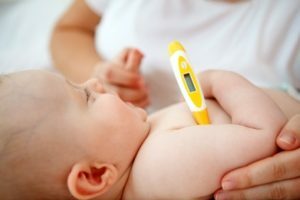 To measure the temperature of infants, the thermometer is placed in the inguinal fold or underarm in the period of calmness of the crumbs. Skin covers at the point of contact with the thermometer should be dry and warm.
To measure the temperature of infants, the thermometer is placed in the inguinal fold or underarm in the period of calmness of the crumbs. Skin covers at the point of contact with the thermometer should be dry and warm.
Another option is to measure rectal temperature, when a creamy tip of the thermometer is injected into the baby's rectum for 5 minutes.
In this case, it should be remembered that for the rectal temperature the normal values are 37-37.5 degrees, and the elevated values are more than 38.5 degrees.
If permanent teeth
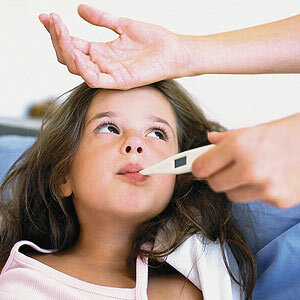 climb As a rule, the eruption of permanent teeth, even at a very young age, passes almost imperceptibly due to the strengthening of immunity and the body's ability to withstand such stresses.
climb As a rule, the eruption of permanent teeth, even at a very young age, passes almost imperceptibly due to the strengthening of immunity and the body's ability to withstand such stresses.
Nuisances can occur only when large molars and premolars erupt, when the risk of infection of the inflamed gingiva increases, resulting in increased temperature.
In view of the fact that such teeth are cut after reaching the baby of six years of age, it is enough to simply determine the cause of the temperature according to the complaints of the child.
In what situations you need to knock down the temperature
The temperature values that need to be lowered are determined depending on the age of the crumb.
Six month old children can normally tolerate even high temperatures up to 38.5 degrees. If the teeth are cut in the infant( which is often enough), the temperature requires special attention when it rises slightly more than 38 degrees.
In addition, to reduce the temperature, even if it did not reach 38 degrees, you need if the child feels unwell, when he practically does not sleep, becomes very restless and constantly cries.
How dangerous is the fever of a child?
For children of the first year of life the temperature above 39 degrees is especially dangerous because of the high probability of occurrence of respiratory disorders, heart rhythm. Such complications result from the relative immaturity of the brain and other organs.
As the baby grows, the risk of developing such a scenario is reduced and becomes minimal by 3-5 years.
It should be remembered that it is impossible to sharply knock down the temperature, it is enough to reduce it to a degree or a half to begin with.
How to knock down the temperature
You can lower the temperature using physical methods or drug therapy. It is impossible to say which of them is preferable.
Everything depends on the specific situation and possibilities. Many parents start with physical impact, and if it does not give results, go to febrifuge.
Physical methods
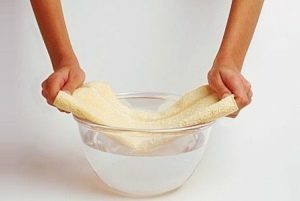 First of all, the baby needs to be freed from excess clothing and diapers, which provoke an additional overheating of the body, preventing perspiration and heat regulation. At an elevated temperature, a cotton shirt or light t-shirt is enough for a crumb.
First of all, the baby needs to be freed from excess clothing and diapers, which provoke an additional overheating of the body, preventing perspiration and heat regulation. At an elevated temperature, a cotton shirt or light t-shirt is enough for a crumb.
One of the options for non-medicamentous temperature reduction is complete wiping with herbs, for which a liter of infusion is made from chamomile, yarrow and St. John's wort.
In the resulting liquid, wet a thin towel or cotton diaper and quickly wrap the baby's body, leaving the handles and feet open.
Then the child is wrapped in a blanket, the legs are put on 2 pairs of socks: down - soaked in infusion and from above - warmer. After 40 minutes the baby is wrapped, quickly dipped in warm water( the water temperature should be 37 degrees), wipe dry and put in bed.
Here, the choice is left for parents who put folk methods on one side of the scale, and on the other - drug therapy. For wiping a soft cloth, moistened in vodka or vinegar, is used. To prepare the first one will need a glass of water and 50 grams of vodka, for the second - a liter of water and a tablespoon of vinegar.
Wipe gently( only rub the inner surfaces of the legs and hands, soles and palms more thoroughly), so as not to injure the baby's skin, putting on the baby after the procedure dry clothes. In between rubs, it is possible to cool the crumb with a wet wipe placed on the forehead.
For kids over the year, a warm shower will do, which will help not only lower the temperature, but also relieve tension.
Drug therapy
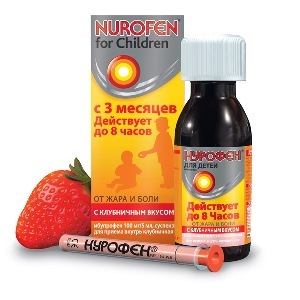 If physical methods prove to be ineffective, you need to start drug therapy.
If physical methods prove to be ineffective, you need to start drug therapy.
The main drugs are Paracetamol, Panadol( based on paracetamol) and Nurofen( the active ingredient is ibuprofen), which are allowed to be used from three months.
They have antipyretic and analgesic effect, so they greatly facilitate the condition of crumbs. Breast children, at the age of 1 month, can be given Paracetamol-based Efferalgan( available in the form of syrup or candles).
Preparations based on paracetamol in the form of syrups or suppositories are recommended by pediatricians more often because of the strong action of Ibuprofen and the reluctance to immediately accustom the tiny organism to such medicines. Take antipyretic should follow the instructions.
Recommendations from Dr. Komarovsky for reducing temperature:
What not to be done categorically
Earlier, the alternative to paracetamol and Ibuprofen was antipyretic, the active substance of which is Nimesulid( Naiz, Nimulid).
Because of the greater toxicity compared to other agents, they were prescribed only by the doctor in critical situations for a period of not more than 3 days. Today, due to the likelihood of developing toxic hepatitis, the attitude towards such drugs is more critical.
The first is a highly toxic drug that depresses hemopoiesis. The only variant of its application is the "lytic mixture" in injections, which the ambulance does when the child develops a "white fever"( against the background of a harsh fever, the pallor of the skin, the coldness of the legs and hands).Aspirin is contraindicated because of the risk of developing Reye's syndrome with toxic liver damage.
Baby care
Suffering from pain and heat, refusing to eat a baby, requires a special attention and special conditions that will help ease his condition.
Correcting the diet
First of all, a temperature-sensing baby needs to provide an enhanced drinking regime because of the high probability of dehydration. For kids older than 5 months, juices, fruit drinks and fruit juice and compotes of room temperature from sour-sweet fruits and berries are optimal.
It is not necessary to feed a baby in any way. With the lure while you can wait, offering the child a mixture or breast milk. When teething, the child instinctively tries to chew or suck, so at least some amount of nutrients, he will still get.
 If the child does not give up the complementary feeding, it is desirable to saturate his diet with products with a minimum content of animal proteins, offering small portions at short intervals.
If the child does not give up the complementary feeding, it is desirable to saturate his diet with products with a minimum content of animal proteins, offering small portions at short intervals.
Creating the appropriate microclimate
At high temperatures, the comfortable atmosphere in the room is important for the child. It is important to ensure sufficient air humidification( with the help of a moisturizer, wet towels and sheets draped around the room, containers of water) and a temperature of no higher than 21 degrees.
Also, it is advisable to periodically ventilate the room, taking away the crumbs for another time.
Watching clothes and linen
As already mentioned, the clothes of a child who has a fever temperature should be light and present in a minimal amount.
Preference should be given to cotton things that will not interfere with skin breathing. It is important to monitor the dryness of the laundry and things, changing wet shirts or sheets in due time( with a decrease in temperature, the baby may have increased sweating).
Situations requiring the advice of a physician
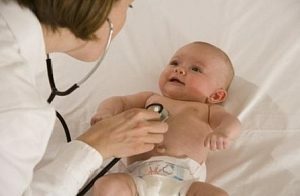 Many young parents call a doctor right after finding a fever in a child.
Many young parents call a doctor right after finding a fever in a child.
If in addition to the temperature there are all the other signs of teething, you can wait a visit to the doctor for 3 days.
With prolonged heat, a mandatory examination of the pediatrician is required, which will determine the cause of the fever, control the heart rhythm of the baby and the work of other body systems to avoid dehydration and exhaustion.
To urgently call a physician is needed in the following situations:
- aggravation of the condition of the crumbs , characterized by redness of the face, drying out of the lips and skin, glitter of eyes, rare urination, constant crying;
- high temperature( above 39-40 degrees) with respiratory depression, excessive activity or passivity of the child, pallor or dullness of the skin, cramps, coldness of legs and hands.
When temperature indicates the development of diseases
When teething, the temperature is a secondary symptom associated with the characteristic local symptoms.
If the fever disturbs the baby for a long period, reaching high values and getting easily medicated, it is necessary to exclude the development of an infectious disease.
Also, the presence of an infection in the body can be indicated by the appearance on the background of temperature:
- vomiting;
- diarrhea( especially with bloody or mucous inclusions);
- rash.
In such situations, only the doctor can diagnose correctly.
